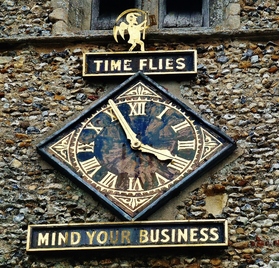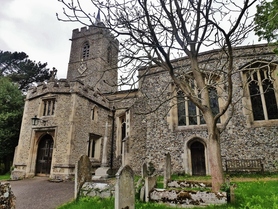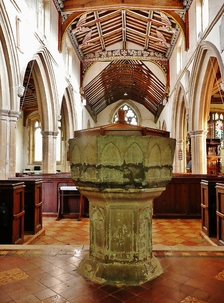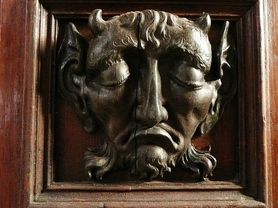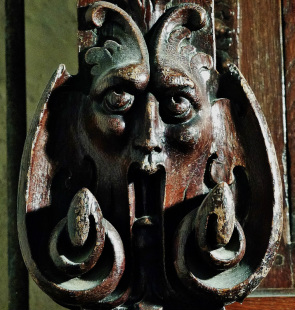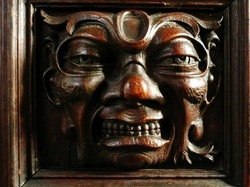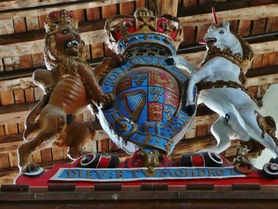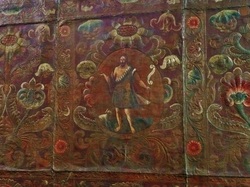St. Mary, Furneux Pelham.
Time for angels.
“Time flies, mind your business”. So reads the motto by the clock on the fourteenth century flint tower here, though you’d never believe it in this timeless countryside close to Essex, between Barleycroft End and Merlin Wood. It’s a slender tower, with a fat little Hertfordshire spike, and over the clock face is old Father Time. From the road everything builds up to it quite nicely, with the two storey porch balanced by the big transeptal south chapel, both of them extending some way beyond the aisles which clasp the tower. The porch dates from the fifteenth century, the chapel was built by Robert Newport in 1518, almost as a separate building. Inside it’s the nave roof that grabs our gaze, having been restored in 1964, when the angels regained their amputated wings and the roof its rainbow hues. It’s a low tie-beam and arched brace roof, with big angels just for show, and the colouring livens the church up no end, as well as clarifying the detail on the wall plate, often lost in the gloom. In the south aisle there’s an early fifteenth century tomb chest with a very good brass indeed on the top to Sir Walter and Lady de la Lee, a civilian couple under an elegant double canopy. Brasses are ubiquitous in Hertfordshire, aesthetic standards slipping downhill all the time, but this one bucks the trend with simplicity of line that denotes a sure handed craftsman. Unfortunately, the tomb is trapped behind a screen dividing off a vestry, on top of which are the carved and coloured royal arms of Charles I, dated 1634 and with some questionable spelling.
Time for angels.
“Time flies, mind your business”. So reads the motto by the clock on the fourteenth century flint tower here, though you’d never believe it in this timeless countryside close to Essex, between Barleycroft End and Merlin Wood. It’s a slender tower, with a fat little Hertfordshire spike, and over the clock face is old Father Time. From the road everything builds up to it quite nicely, with the two storey porch balanced by the big transeptal south chapel, both of them extending some way beyond the aisles which clasp the tower. The porch dates from the fifteenth century, the chapel was built by Robert Newport in 1518, almost as a separate building. Inside it’s the nave roof that grabs our gaze, having been restored in 1964, when the angels regained their amputated wings and the roof its rainbow hues. It’s a low tie-beam and arched brace roof, with big angels just for show, and the colouring livens the church up no end, as well as clarifying the detail on the wall plate, often lost in the gloom. In the south aisle there’s an early fifteenth century tomb chest with a very good brass indeed on the top to Sir Walter and Lady de la Lee, a civilian couple under an elegant double canopy. Brasses are ubiquitous in Hertfordshire, aesthetic standards slipping downhill all the time, but this one bucks the trend with simplicity of line that denotes a sure handed craftsman. Unfortunately, the tomb is trapped behind a screen dividing off a vestry, on top of which are the carved and coloured royal arms of Charles I, dated 1634 and with some questionable spelling.
Under the tower there’s a damaged early thirteenth century font bowl of Purbeck marble sitting on a later shaft, the bowl having been smashed at the time of the Commonwealth when thrown out of church, and to the east is a chancel of roughly the same date with lancet windows, one of which has the bright stained glass of the 1850s. Nearby on the north wall is a seventeenth century Portuguese reredos made of stamped and coloured leather. There is a sedilia and piscina group with stiffleaf capitals too, and a blocked low side window - and whilst we’re at it, let’s scotch that “lepers’ window” myth that crops up time after time in uninformed guide books; lepers were not allowed into villages or towns, and certainly nowhere near a church. Low side windows occur in varying numbers in churches, always close to an altar, originally closed with a wooden shutter rather than glazed. They were probably dual purpose, opened in order that the sacring bell[21] could be heard outside the church, but also for ventilation after incense: for smells and bells.
It is in the Newport chapel that the best fittings are found, though a lot of space has been taken up by the organ. Robert Newport has a brass plaque here of 1518, engraved with kneeling figures, and there’s a chest tomb of 1624 for Edward Cason, with heraldry set in swags of marble on the front. At some time a large ornate cupboard ended up in here, probably when it was decided to use it as a vestry. It is partly Victorian, but with a lot of foreign mannerist carved work of the seventeenth century used in its construction, grotesques, green men, swags of fruit, putti, beasts and screaming heads, all topped by a heavy cornice. It is big enough to act as a room divider, and must weigh a ton. During the 1860s, the Calvert family refurbished the chapel, presumably before the organ moved here, and fitted stained glass by William Morris and Edward Burne-Jones, early work by these designers before Burne-Jones in particular had settled into his final style. Somewhat lost here are delicate fragments from the head of a sixteenth century screen, with various coats of arms held by unusual animal supporters set in fine timber filigree, all cut from single boards and retaining much colour.
The church is well looked after, and generally open, if not, the vicar is on 01279 842609.
The church is well looked after, and generally open, if not, the vicar is on 01279 842609.
[21] Small handbell rung to mark the elevation of the host, at the moment of high magic, when the bread and wine was believed to become Christ’s body and blood.
All rights reserved for this entire site. Copyright reserved to stiffleaf for all text and images, which may not be reproduced without my permission.
